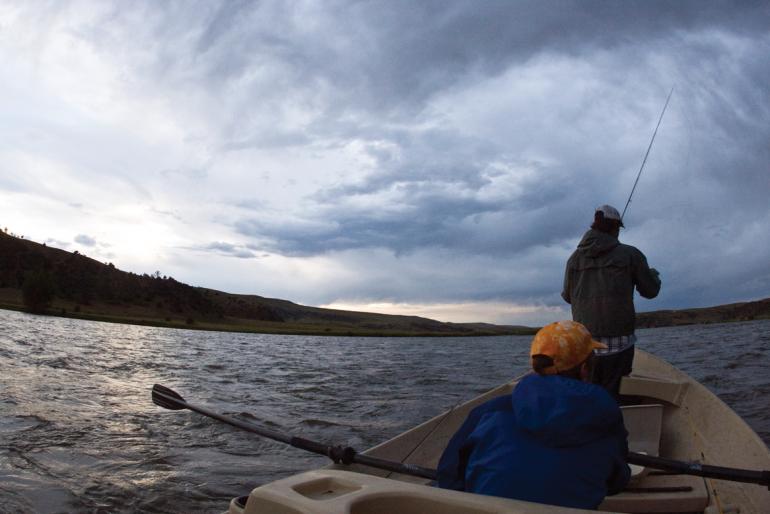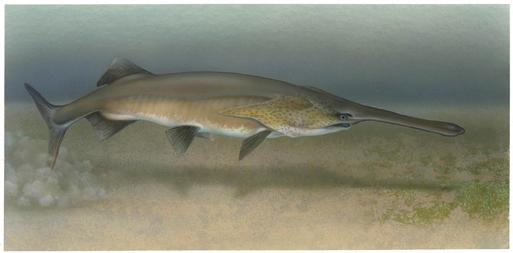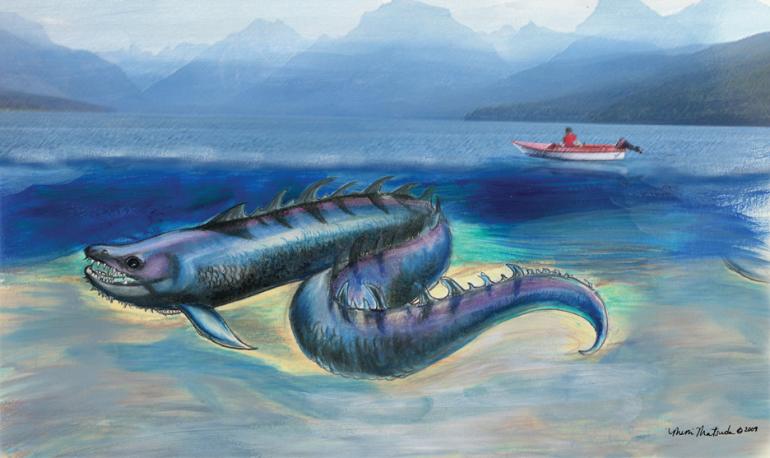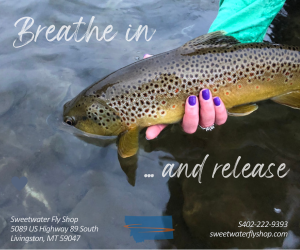Montana Fish Stories
Whether it’s the quest for monster trout, the search for the Flathead Monster, or the snagging of prehistoric fish, Montana lays claim to some impressive big-fish lore. Here’s a look at some of the best-known Big Sky fishing legends.
Old Fighter: The Quest for the Big Daddy Trout
The stereotypical fisherman exaggerates, whether it’s about how big his catch was or how many he had on the line. There’s the legendary tale of “the one that got away,” but what’s even more vivid in the active imagination of the fisherman is the vision of that one big-daddy trout lurking in a deep, dark hole, waiting to meet the anxious angler on the other end of the line.
“I’m always looking for ‘Old Fighter,’” says Rod King, owner of Bozeman Angler in downtown Bozeman. “In the movie On Golden Pond, he’s looking for Walter. All my life, I’ve been looking for the biggest guy in the river. I know there’s some double-digit trout in the water, and I hope to find one.”
King isn’t alone. It seems that most trout hunters have similar hopes.
“We hear so many big-fish stories, it’s hard to pick one out,” says a salesman at a Bozeman fly-fishing shop who asked to remain anonymous. But are these fishermen intentionally lying? “I think they’re telling their perception of the truth,” he says. “I don’t think most fishermen set out to lie about the fish. I think they believe it—everyone kind of sees them as being bigger than they are. You’d have to talk to a psychologist to figure out why.”
“I’ve never quite understood the allure of the giant trout,” says MSU professor Jack Jelinski, a fisherman with a 60-year habit. “I think they seek the big trout because they’ve probably never caught the giant fish. I’ve fished in Alaska and caught a 40-pound salmon on a fly rod. I’m just as happy to catch a 10- to 12-inch brook trout in a Montana stream with a four-weight as I am to catch a big brown trout on the Missouri with a six-weight [rod].”
But Jelinski goes on to enthusiastically relay a story about one renowned fisherman who had the fishing community abuzz after finally catching his version of “Old Fighter.” In June of 2006, Bob Jacklin, one of the area’s most well-known outfitters and owner of a long-standing fly shop in West Yellowstone, caught a 10-pound, 30-inch brown trout on the upper Madison River. And this wasn’t a stretch of his imagination; not only did he have this big daddy mounted, he also had it caught on film.
“It was the biggest brown trout of my life,” Jacklin says. “My quest for years was to get a 10-pound fish. I got seven, eight, and nine pounds, and let them all go. I always assumed it would be on the Missouri River.” Up until this past fall, his was a record fish for the Madison.
In his 40th year of guiding, Jacklin admits that although most of his clients are indeed seeking the monster trout, quantity is more important. “All of us fisherman have the dream of catching the big fish, the monster,” he says, “but a good time is quantity to keep us busy.”
In his personal fishing experiences, the 10-pounder he caught that day in June fulfilled a dream for him. “It felt really good,” he says. “It was all luck, along with my knowledge of playing a fish. When I die, that fish goes to Fish and Game.” Check out Jacklin’s big catch on YouTube.
The 65-Million-Year-Old Fish
Each year, from late May through June, thousands of anglers flock to eastern Montana on a quest for the legendary paddlefish—quite possibly the oldest big-game species surviving in North America. If you’ve never seen a paddlefish before you catch sight of one dangling on your line for the first time, it could come as quite a shock. “Damn, that’s one ugly fish!” you might say.
But what’s ugly to some is beautiful to others. “They’re cute,” says Greg Keeler, avid fisherman and author of the book Trash Fish, a must-read for up-and-coming paddlefish fishermen. “They look like a 1940 Hudson, with that big roundish cartoonish face, teeny eyes, and a big schnozz.”
The allure of paddlefish is undeniable—these fish are rare, odd-looking, and they have a lot of meat. But instead of the fly rod you’ll need deep-sea fishing gear, and because we live in Montana, where most don’t have this kind of equipment, other objects from the garage will suffice. “You snag them because they’re bottom feeders,” Keeler explains. “Put a giant three-pronged hook on a spark plug, and drag it across the current to where they’re slacked up behind the irrigation dams on the Yellowstone.”
Besides the paddlefish populations in a handful of spots in Montana—the Intake Diversion Dam in Glendive being one of the most popular—they are found only in Mississippi River drainage areas and the Yangtze River drainage in China.
In 1938, a team of scientists uncovered paddlefish fossils along with a 65 million-year-old duck-billed dinosaur, indicating that these fish have been in Montana ever since. So catching one can be a double-edged sword with a three-pronged hook.
“You feel like you’re slaughtering this ancient thing,” Keeler says, “and I kind of feel bad about it.”
The Flathead Lake Monster
The year was 1889, and Captain James C. Kerr was skippering the U.S. Grant lake steamer as it chugged its way across the expansive Flathead Lake. Out of nowhere appeared a large wake in the water accompanied by a shadow approaching the boat, large enough that a passenger, thinking it was a whale, fired a bullet into the water. That was the first documented sighting of “Nessie,” aka the Flathead Monster.
“I named him a ‘creature,’” says Laney Hanzel, a retired fisheries researcher for Fish, Wildlife & Parks and the current record keeper of sightings. “It’s different than a monster, not hideous. A monster destroys things. There’ve been no mortalities or sinking of boats.”
Hanzel classifies any sighting of something 10 feet or less in length as a large fish, and those above 10 feet, the largest sighting being around 40 feet, is classified as a creature. And although Hanzel himself has never laid eyes on the Flathead creature, he believes those who have. “I’ve talked to over 20, and they’re not kooks,” he says. They’re not drunk or on drugs… in 15 to 20 sightings there were a lot of similarities.”
Since 1889 there have been over 80 documented sightings, most occurring in the summer months. Most describe an eel-like shape, 30 to 40 feet long and about three to four feet in diameter, with steely black eyes, and a movement that undulates through the water, rolling up and down.
Is this creature a figment of the imagination? Could Nessie be a remnant from Montana’s dinosaur days? “I don’t know of any mammal or fish it could represent besides a prehistoric creature,” Hanzel says. “I worked on the lake for over 25 years and didn’t see it, but I have to believe what people say. As far as I know, all large lakes seem to have some sort of a myth about some large creature.”
But according to Hanzel, it’s probably not worth the trip specifically for monster sighting. “You have a better chance of winning the lottery than sighting the Flathead Lake Monster,” he says. Therefore, it remains a Big Sky legend.
RECORD BIG FISH
Brown Trout: 29 lbs., Wade Lake, 1966
Bull Trout: 37” long, 25.63 lbs., caught with trolling line, 1916
Cutthroat Trout: 16 lbs., Red Eagle Lake, 1955
Golden Trout: 23.5” long, 5.43 lbs., caught with Malixi lure, 2000
Lake Trout: 42.5” long, 42.69 lbs., caught with flatfish, 2004
Paddlefish: 77” long, 142.5 lbs., Missouri River near Kipp Park, snagged, 1973
Rainbow Trout: 38.62” long, 33.1 lbs., Kootenai River, caught with lure, 1997
Rainbow-Cutthroat Hybrid Trout: 35.75” long, 30.25 lbs., Ashley Lake, caught with bait, 1982
(Courtesy Montana Fish, Wildlife & Parks.)
WHAT IF YOU CATCH THE RECORD-BREAKING "OLD FIGHTER"?
To prevent loss of weight, do not clean or freeze the fish. Keep the fish cool—preferably on ice.
Take a picture of the fish!
Weigh the fish on a certified scale (found in grocery or hardware stores, etc.), witnessed by an observer. Get an affidavit from the store if no FWP official is present. Measure the length.
Contact the nearest FWP office to have the fish positively identified and to determine if it is a state record.
Fill out the Fish Record Form and send it to: Beth Giddings, Fisheries Division, Montana Fish, Wildlife & Parks, PO Box 200701, Helena, MT 59620-0701.
(From fwp.mt.gov/fishing/fishingmontana/fishrecords.html)













